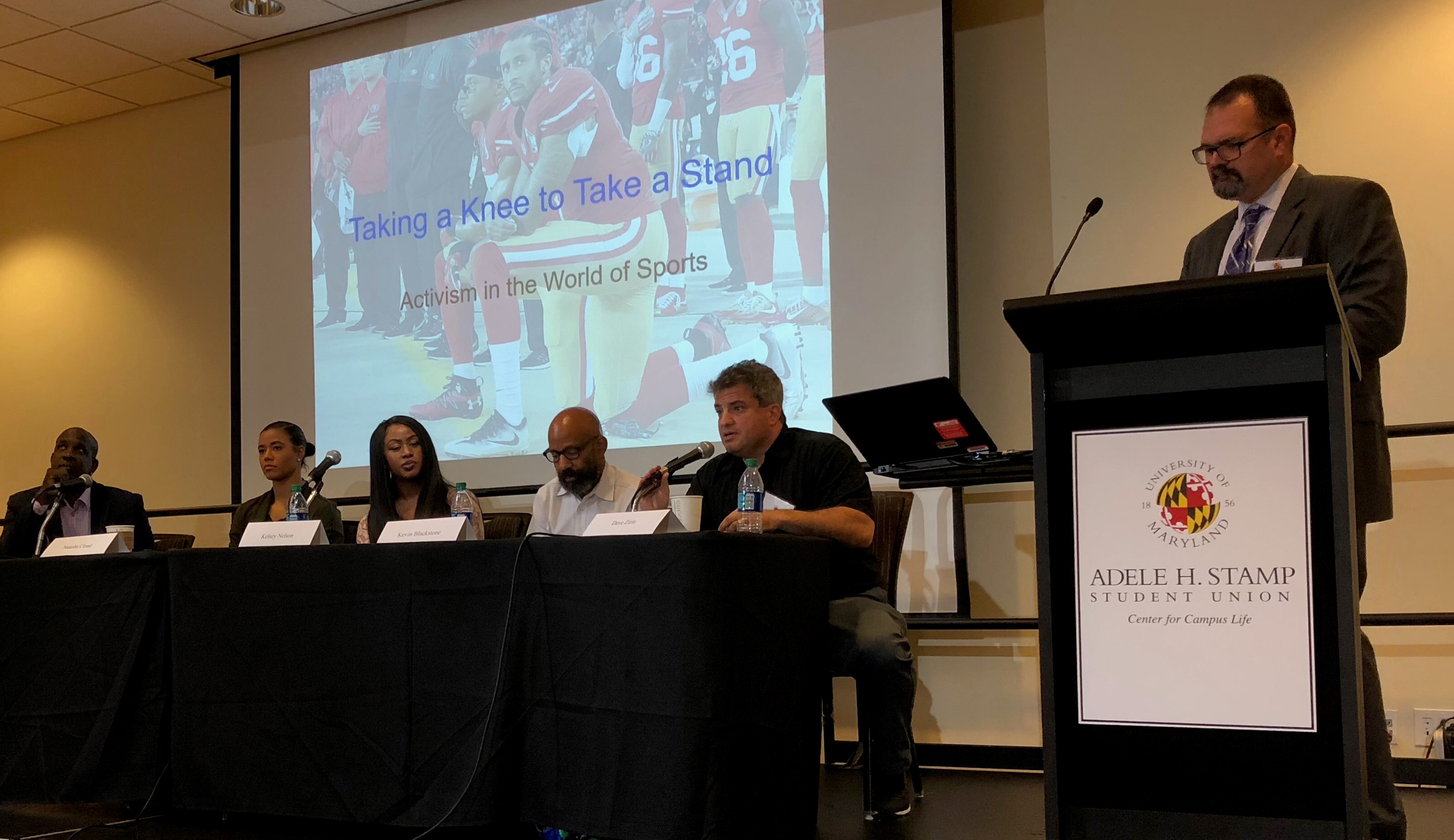By Anastasia Marks
For The Diamondback
When his students are watching Nike’s new commercial featuring former San Francisco 49ers quarterback Colin Kaepernick, University of Maryland journalism professor Kevin Blackistone wants them to recognize one thing: The ad has nothing to do with police brutality, or kneeling during the national anthem.
“The cult of personality takes over that ad at the end,” Blackistone said. “He is becoming, now, an iconic figure, kind of a silhouette. And I’m not certain how that’s going to play out.”
At the African-American Studies department symposium “A View from the Mountaintop: 50 Years Later,” held in Stamp Student Union on Wednesday, Blackistone joined several other experts across sports, economics and politics, discussing how sports and money are intertwined with activism, the progress people of color have made in their push for equality and a range of other topics.
[Read more: Kevin Blackistone, UMD community discuss roles of athletes in activism]
Blackistone — speaking on the forum’s first panel, “Taking a Knee to Take a Stand” — used Kaepernick as a recent example of money influencing activism and sports.
Kaepernick hasn’t played in the NFL since the 2016 season, when he began kneeling during the national anthem to protest racism and police brutality. His demonstration sparked a nationwide debate about racial equality that is still raging today.
This month, Nike announced a major advertising campaign with Kaepernick as its face.
“We can never underestimate the importance of money,” said Robert Turner, a neurology professor at George Washington University.
[Read more: Civil rights experts say students are engines of activism at UMD forum]
Nearly every panelist said the role of money in sports stifles activism and prevents athletes from showing support for marginalized groups, especially in the case of male athletes supporting female athletes.
Blackistone highlighted recent comments from WNBA players, who have argued they should receive a greater proportion of league revenue. Less than 25 percent of WNBA revenue goes toward players’ salaries, whereas about 50 percent of the NBA’s earnings is paid to players, according to Forbes.
“It would be great if NBA players could support their sisters in the WNBA who are being treated like second-class citizens,” Blackistone said. “When the women’s hockey team threatened to go on strike, the NHL players stood up and said, ‘We got your back.’ And it would be great to see the same from the NBA players.”
The forum also touched on activism aimed at promoting a healthier culture for all genders, ages and economic levels in athletics.
These sentiments come not long after Jordan McNair, a member of the Maryland football team, died from heatstroke he contracted at a team workout. ESPN reported last month that the team’s coaches were coercing players to push themselves beyond their physical limits.
“All sports are trying to monetize off of kids [in youth sports],” said panelist Kelsey Nelson, a graduate of this university’s journalism school and sports journalist. “You see parents going broke just to see kids play. … That’s the reality we’ve made today: ‘Do whatever it takes.'”
The power of money and economics over marginalized groups were another major points of discussion in the symposium’s second panel, “The State of Black America 50 Years after Kerner,” which focused on the half-century of progress following the 1968 Kerner Commission Report from the Johnson administration.
The panelists discussed how people of color in the United States are exploited for the profit of the criminal justice system.
“Something … I hope contemporary scholars will spend more time looking at is the extent to which police violence is economically profitable for some people,” said Julianne Malveaux, former president of Bennett College. “Who’s being extracted from what precincts and what does that mean? Who’s being incarcerated where?”
Malveaux, an economist, questioned how banks owned by people of color have closed due to lack of support and how much white bank owners and bank clients profit from such actions.
“We really have to begin to look at how white racism [is] intertwined with predatory capitalism,” Malveaux said. “In other words: Who benefits from poverty? Who benefits from white racism? And if you’re working class and white, it [isn’t] you.”
Junior economics major Chenoa Orr appreciated Malveaux’s discussion of how race and economics have progressed in the five decades following the Kerner report.
“I found it interesting how they reflected on it 50 years after and talking about ‘How far have we really gotten?'” Orr said. “People love to say we’ve come so far, but have we really? We still have quite a way to go.”



